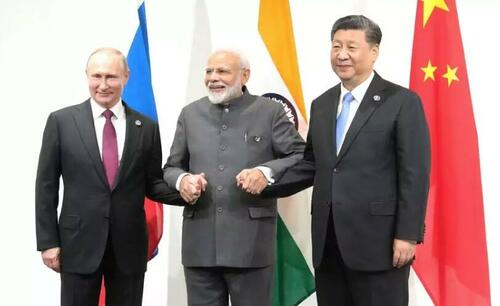
The US dollar, as the world’s reserve currency, is the most widely accepted and held currency by central banks and governments around the world for international trade and financial transactions. This status was established after World War II, when the Bretton Woods Agreement was signed, designating the US dollar as the anchor currency for the international monetary system.
The US thinks that it can carry a debt-to-GDP ratio of +134% because we are the world’s reserve currency. That is quickly eroding. And we will soon find ourselves in Japan’s and WW2 Germany’s position.
If you get a chance, read up on BRICS (Brazil, Russia, India, China and South Africa). It consists of more than a quarter of the world’s GDP and about 40% of the global population. During the 14th BRICS Summit in June 2020, Russian President Vladimir Putin announced plans to explore creating a new reserve currency outside the Western framework.
Reuters reported on Wednesday that “India’s Oil Deals With Russia Dent Decades-Old Dollar Dominance”, which informed their audience that the growing trend of those two using national or third-party currencies like the UAE’s is something significant for everyone to pay attention to. To that outlet’s credit, it also reminded readers that IMF Deputy Managing Director Gita Gopinath foresaw in the month after Russia’s specialoperation began that the West’s sanctions “could erode the dollar’s dominance”.
Lo and behold, that’s precisely what happened, with India of all countries accelerating de-dollarization through its non-dollar-denominated energy deals with Russia. About them, Russia has since become India’s largest supplier over the past year and now provides a whopping 35% of that country’s needs, which is also the world’s third-largest oil importer and fifth-largest economy. Their new energy ties, and particularly the growing de-dollarization dimension of their deals, are thus globally important.
None of what was just described is driven by any anti-American animus on India’s part since everything is purely motivated by the pursuit of that country’s objective national interests. Delhi had no choice but to gradually diversify away from dollar-denominated energy deals with Moscow due to Washington’s illegal sanctions. Its multipolar leadership wasn’t going to let the world’s most populous country slip into an economic crisis just to please the US by eschewing the import of discounted oil from Russia.
By defying American pressure upon it to unilaterally concede on those aforementioned objective national interests, India’s economy ended up growing at twice the pace of China’s, which contributed to catapulting that country to the forefront of the global systemic transition to multipolarity. Amidst the impending trifurcation of International Relations, India is now poised to de facto lead the GlobalSouth in helping fellow developing countries balance between the GoldenBillion and the Sino-Russo Entente.
Had India complied with the US’ illegal sanctions, then the New York Times wouldn’t have recently admitted that those restrictions failed just like the West’s efforts to “isolate” Russia did as well. It was largely due to that South Asian Great Power’s truly independent grand strategy that this latest phase of the New Cold War didn’t decisively end in the Golden Billion’s victory over Russia and the restoration of unipolarity, which would have been detrimental to India and every other developing country’s interests.
India therefore changed the course of history by remaining committed to the pursuit of its objective national interests, which to remind everyone, aren’t driven by any desire to harm the interests of third parties like the US. Its leading role in de-dollarization via its increasing number of non-dollar-denominated energy deals with Russia is also reshaping the global financial system by reducing that currency’s prior dominance and thus leading to a more multipolar state of affairs for everyone.
Even the US itself seems to have finally accepted that it can’t reverse this trend, which is evidenced by former Indian Ambassador to Russia Kanwal Sibal recently telling TASS that “Lately, the discourse from Washington has changed and India is no longer being asked to stop buying oil from Russia. In a recent visit to India, the US Treasury Secretary actually said that India can buy discounted oil from Russia as much as it wants so long as western tankers and insurance companies are not used.”
Nevertheless, radical liberal–globalistideologues like Color Revolutionmastermind George Soros are still desperately clinging to the dream of restoring the US’ rapidly declining unipolar hegemony, hence why he de facto declaredHybridWar against India during the Munich Security Conference last month. It remains unclear whether he and his network have enough support in the Western Establishment to advance that regime change agenda, but his threat is still worrisome and should be taken seriously.
Reuters’ latest report about India’s role in accelerating de-dollarization might fuel interest among likeminded “Western Exceptionalists” in supporting his de facto Hybrid War against that country so observers should closely monitor related developments in order to assess whether this happens. In any case, those who sincerely support multipolarity should loudly applaud India for its indispensable role in comprehensively facilitating this process, especially its financial dimension as described in this analysis.
India Takes A Leading Role In De-Dollarization – The Automatic Earth
Henri Matisse Young Woman at the Window, Sunset 1921 Andrew Korybko: Reuters reported on Wednesday that “India’s Oil Deals With Russia Dent Decades-Old Dollar Dominance”, which informed their audience that the growing trend of those two using national or third-party currencies like the UAE’s is something significant for everyone to pay attention to.